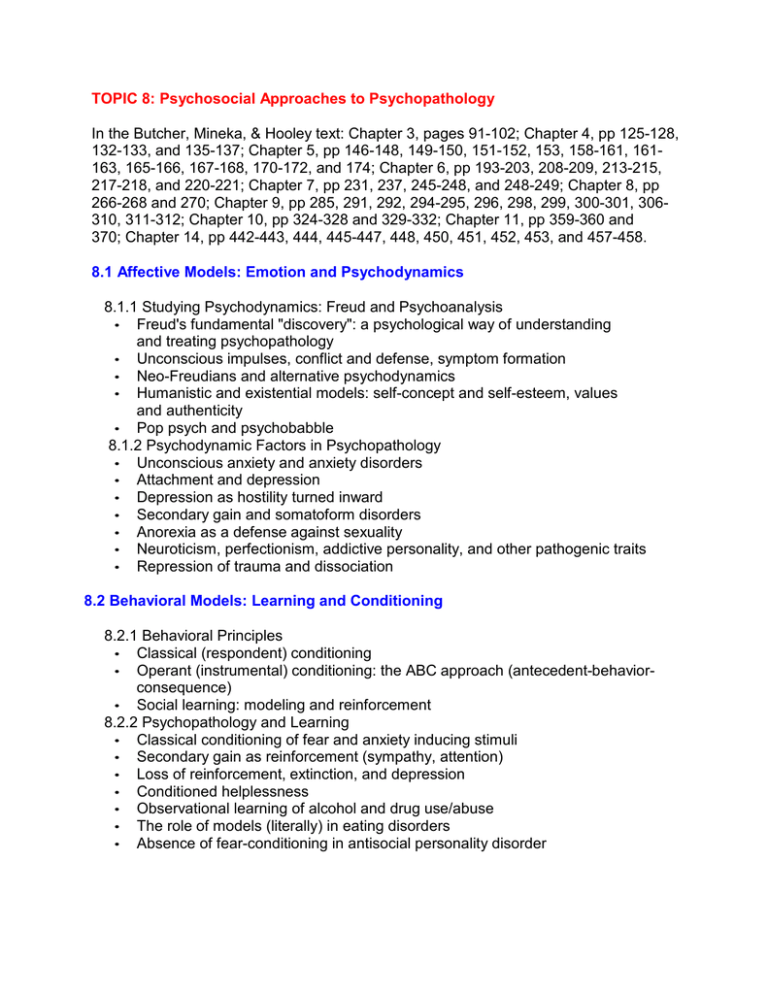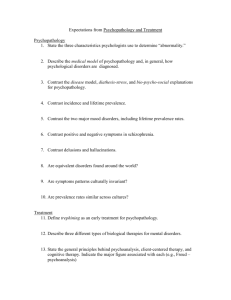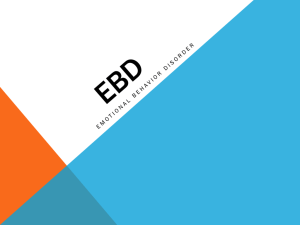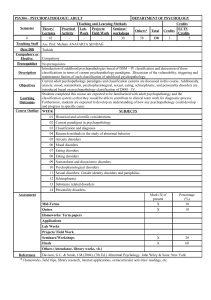TOPIC 8: Psychosocial Approaches to Psychopathology
advertisement

TOPIC 8: Psychosocial Approaches to Psychopathology In the Butcher, Mineka, & Hooley text: Chapter 3, pages 91-102; Chapter 4, pp 125-128, 132-133, and 135-137; Chapter 5, pp 146-148, 149-150, 151-152, 153, 158-161, 161163, 165-166, 167-168, 170-172, and 174; Chapter 6, pp 193-203, 208-209, 213-215, 217-218, and 220-221; Chapter 7, pp 231, 237, 245-248, and 248-249; Chapter 8, pp 266-268 and 270; Chapter 9, pp 285, 291, 292, 294-295, 296, 298, 299, 300-301, 306310, 311-312; Chapter 10, pp 324-328 and 329-332; Chapter 11, pp 359-360 and 370; Chapter 14, pp 442-443, 444, 445-447, 448, 450, 451, 452, 453, and 457-458. 8.1 Affective Models: Emotion and Psychodynamics 8.1.1 Studying Psychodynamics: Freud and Psychoanalysis • Freud's fundamental "discovery": a psychological way of understanding and treating psychopathology • Unconscious impulses, conflict and defense, symptom formation • Neo-Freudians and alternative psychodynamics • Humanistic and existential models: self-concept and self-esteem, values and authenticity • Pop psych and psychobabble 8.1.2 Psychodynamic Factors in Psychopathology • Unconscious anxiety and anxiety disorders • Attachment and depression • Depression as hostility turned inward • Secondary gain and somatoform disorders • Anorexia as a defense against sexuality • Neuroticism, perfectionism, addictive personality, and other pathogenic traits • Repression of trauma and dissociation 8.2 Behavioral Models: Learning and Conditioning 8.2.1 Behavioral Principles • Classical (respondent) conditioning • Operant (instrumental) conditioning: the ABC approach (antecedent-behaviorconsequence) • Social learning: modeling and reinforcement 8.2.2 Psychopathology and Learning • Classical conditioning of fear and anxiety inducing stimuli • Secondary gain as reinforcement (sympathy, attention) • Loss of reinforcement, extinction, and depression • Conditioned helplessness • Observational learning of alcohol and drug use/abuse • The role of models (literally) in eating disorders • Absence of fear-conditioning in antisocial personality disorder 8.3 Cognitive Models 8.3.1 Cognitive Psychology • Attributions and schemas • Expectancies • Problem-solving and coping styles • Self-efficacy 8.3.2 Cognitive Factors in Psychopathology • Perception of danger, sensitivity to threat in anxiety disorders • Catastrophic thinking in panic disorder • The paradoxical effect of thought suppression in OCD and GAD • Dysfunctional beliefs and Beck's negative triad (self, experiences, future) • Pathogenic attributions: helplessness and hopelessness • Attributional styles: internal/external, global/specific, stable/unstable) • Expectancies and alcohol and drug use • Executive control, delay of gratification and disruptive behavior disorders, antisocial personality disorder 8.4 Developmental Models 8.4.1 Family and Interpersonal Models • Socialization • The family as a system • Parent-child relationships and parenting • Peer influences 8.4.2 Family and Interpersonal Influences on Psychopathology • Family adversity • Anxious attachment • Authoritarian, permissive, and neglectful parenting • Abuse • Expressed emotion (EE) • Social support as a protective factor, absence of support as a pathogenic factor 8.4.3 Social Sources of Stress • Trauma • Major life events • Interpersonal conflicts • Societal conditions (economy, social unrest, inter-group conflict, etc.) 8.4.4 Stress and Psychopathology • Precipitating vulnerabilities (diathesis-stress) • Exhaustion and decompensation • Stress as an aggravating factor • Maladaptive coping and adjustment disorders • Trauma and ASD/PTSD • Stress and mood disorders • Stress and physical health 8.4.5 Society, Culture, and Psychology • Do cultures have "personalities"? • Cross-national comparisons • Epidemiological research and the role of sub-cultures • Gender and depression • Standards of beauty, the media, and eating disorders • Ethnicity and substance use disorders • Culture and sexual dysfunction • Gender, society, and paraphilias and sexual violence • Culture and child abuse 8.5 Psychological Treatment Methods 8.5.1 An Overview of Psychosocial Approaches • The major "schools": insight (psychodynamic), expressive (humanistic), learning (behavioral), thinking (cognitive) • Evidence-based treatment (data over theory) • Non-specific factors • "Side-effects"? 8.5.2 Psychosocial Approaches to Emotional Distress • Traditional psychodynamic and humanistic approaches still very popular, widely variable • Behavioral and cognitive-behavioral methods gaining traction, especially with anxiety disorders and depressive disorders 8.5.3 Psychosocial Approaches to Problem Behaviors • Traditional psychodynamic and humanistic approaches becoming less popular, widely variable • Behavioral and cognitive-behavioral methods gaining traction, especially in treating behavior disorders in children, substance use disorders, eating disorders 8.5.4 Psychosocial Approaches to Personality Disorders • Success rates by any means are low, tendency to emphasize long-term traditional psychotherapy • Dialectical behavior therapy and borderline personality disorder 8.5.5 Psychosocial Approaches to Major Mental Illness • Primarily secondary and supportive of medication-focused treatment • Growing evidence of success for behavioral interventions with children on the autism spectrum, schizophrenia 8.5.6 Community-Based Approaches • Primary (universal) and secondary (selective) prevention







